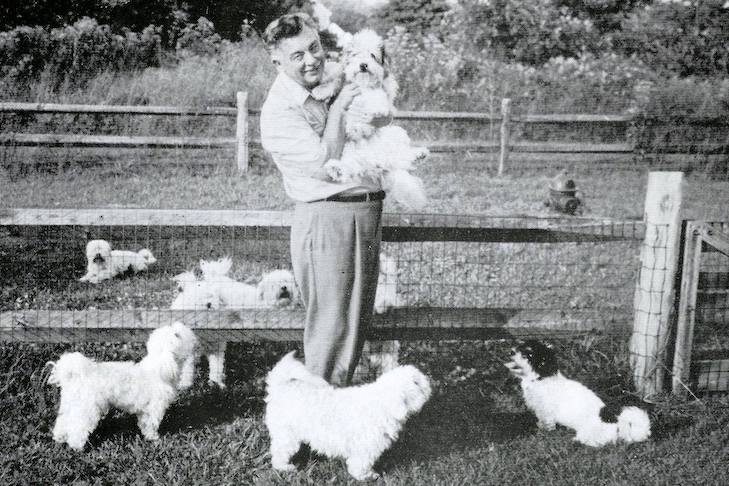Calling all dog lovers! Get ready to dive into the fascinating world of the Coton de Tulear, a breed with a story and personality as rich as its namesake cottony coat. From its mysterious origins to its role as a beloved companion, we’re about to unravel the tapestry of this captivating breed. So, sit back, grab a treat for your furry friend, and let’s embark on a journey through the annals of the Coton de Tulear.
History of Coton de Tulear
The Coton de Tulear, a breed that seems to have just sprung out of a fluffy cloud, actually boasts a history as rich and fascinating as its luxurious coat. These little charmers hail from the exotic island of Madagascar, their journey through time woven with tales of seafaring adventurers and a touch of mystery.
It’s widely believed that their story began with the Bichon Tenerife, a small, fluffy breed popular among sailors and, well, let’s just say “those who acquired riches unconventionally.” These seafarers, plying the trade routes near Madagascar, likely introduced the Bichon Tenerife to the island. Over time, isolated on this diverse and unique land, the breed we know as the Coton de Tulear probably began to emerge.
Madagascar, with its unique environment, likely played a key role in shaping these dogs. Imagine a group of Bichon Tenerife arriving on this island paradise. They encounter a new climate, different terrains, and maybe even different food. Over generations, nature does its thing, perhaps favoring traits that helped them thrive in this new environment. This might explain the Coton de Tulear’s trademark cotton-like coat, perfectly adapted to the island’s climate, and a look that sets them apart from their Bichon ancestors.
Now, the nitty-gritty of exactly how they came to be remains a bit of a head-scratcher for even the most devoted dog historians. Some believe shipwrecks on the shores of Madagascar left behind stranded Bichon Tenerife, who then intermingled with local dogs. Others suggest that wealthy landowners on the island intentionally bred them for companionship and perhaps a touch of exotic flair. There’s even a theory that they were embraced by the Merina people, the ruling class of Madagascar at the time, who declared them “The Royal Dog of Madagascar.” Talk about a pedigree!
While we may never know the absolute truth of their origins, one thing’s for sure: the Coton de Tulear quickly captured hearts. Perhaps it was their playful personality, their soft, hypoallergenic coat that feels like a cloud, or maybe it was their adorable, teddy bear-like faces. Whatever the reason, they went from island dwellers to beloved companions, eventually making their way across the globe to charm dog lovers everywhere.
So, the next time you see a Coton de Tulear, take a moment to appreciate their journey. This breed, with its uncertain beginnings and its undeniable charm, is a testament to the captivating power of history, adaptation, and a whole lot of fluff.
Why Are Coton de Tulears So Rare?
We’ve been diving deep into the Coton de Tulear’s story, and it’s pretty amazing how these fluffy companions have a history as rich as their fur. But that begs the question: why don’t we see them around every corner? What makes them such a rare breed? Let’s unpack the factors that make these dogs so unique and, frankly, a bit hard to come by.
Island Life and a Small Family Tree
Picture this: centuries ago, the Coton de Tulear’s ancestors found themselves on the shores of Madagascar. Talk about an exclusive island getaway, right? But here’s the thing: this isolation meant their dating pool was pretty limited. With a small group to breed with, their gene pool remained small, playing a huge role in why they’re not as common as other breeds. It’s like a family reunion that’s been going on for generations!
Pampered Pooches of Royalty
Back in the day, these weren’t just any dogs. The Coton de Tulear held the prestigious title of “Royal Dog of Madagascar.” Yup, they were literally royalty, treasured companions exclusively owned by the Malagasy nobles. This VIP status meant only a select few could even have them, keeping their numbers incredibly low. It’s like having a diamond-studded leash – not your average pup!
Facing the Unknown: A Breed at Risk
Sadly, life on the island hasn’t been all sunshine and belly rubs. The Coton de Tulear actually faces the very real threat of extinction in their homeland. Factors like habitat loss, diseases, and limited breeding opportunities have made their situation quite fragile. This heartbreaking reality makes every Coton de Tulear out there even more precious. It’s a stark reminder of why conservation efforts are so crucial for their survival.
Healthy Genes, Exclusive Club
Despite their petite stature, Cotons de Tulear are surprisingly healthy pups. They haven’t fallen prey to many genetic health issues, which, while fantastic news, also plays into their rarity. Breeders are extremely careful about who they breed with to protect these good genes and preserve the lineage. It’s like a very exclusive club, with health and heritage being the top requirements.
More to Uncover
Research on canine genetics and historical breeding practices is constantly evolving. While we have some clues about the Coton de Tulear’s rarity, there might be other factors, perhaps even regional variations in their history, that we haven’t uncovered yet. It just goes to show how much more there is to learn about these fascinating dogs!
What Does Coton de Tulear Mean in French?
So, we’ve talked about how adorable Coton de Tulears are, but have you ever wondered what their name actually means? It’s like a little puzzle that unlocks a bit of their history. “Coton” is actually the French word for “cotton,” which makes total sense when you see their cloud-like fur! It’s soft and fluffy, just like a cotton ball.
The second part of their name, “Tulear,” refers to a place – the city of Toliara in Madagascar. This is where these charming dogs originally came from. Putting it all together, “Coton de Tulear” basically translates to “cotton from Toliara.” Pretty straightforward, right? But there’s a certain elegance to it, just like the breed itself.
You see, Coton de Tulears weren’t always widespread. They have a pretty fancy past, believed to be descended from dogs kept by the Merina nobility in Madagascar. These pups were treasured companions and a symbol of high status. So, the next time you see a Coton de Tulear, remember their name tells a story – a story of luxurious fur, exotic origins, and a touch of royal charm.
What Was the Coton de Tulear Bred For?
The Coton de Tulear wasn’t bred for herding sheep or guarding houses. Nope, this little puffball was bred for one thing and one thing only: to be your best buddy. Seriously, these dogs are all about companionship.
Centuries ago, sailors sailing the high seas, would often bring these small white dogs on board. Why? Because everyone needs a friend, even tough sailors! These dogs, possibly the ancestors of our beloved Coton, probably charmed their way into the hearts of everyone they met.
Eventually, these dogs ended up in Madagascar, and the people there fell head over heels. I mean, who wouldn’t? They’re like little clouds of love and fluff! And guess what? The Coton de Tulear became so popular in Madagascar that it’s now their national dog. Talk about making a good impression!
So, what makes them such great companions? Well, first off, they’re incredibly affectionate. They’re practically glued to their humans’ side and love nothing more than a good cuddle session. Plus, they’re not aggressive at all, which makes them perfect for families with kids or other pets. They’re also super playful and relatively easy to train, although they can be a tad independent sometimes.
Oh, and did we mention their coat? It’s not just crazy soft; it’s also hypoallergenic, so they’re a godsend for people with allergies.
All in all, the Coton de Tulear is a fantastic example of a breed that was bred for love and companionship. They’re living proof that sometimes, the best things in life come in small, fluffy packages.
What Are the Disadvantages of a Coton de Tulear?
So you’ve fallen in love with the fluffy charm of the Coton de Tulear? It’s easy to see why! But before you rush into anything, let’s take a look at some things to consider about this breed. Remember, every dog, just like every person, is unique, and while these are potential drawbacks, they might not apply to every Coton out there.
- Allergies and Health Issues: Like many purebred dogs, Cotons can be more prone to certain health issues. Allergies are a big one, which can lead to itchy skin and even nasty infections. Their ears are also super sensitive, thanks to all that fluffy hair, and can easily get infections too. This means more trips to the vet, which can get pricey. Ongoing research is constantly providing new insights into canine health, and what we know about breed predispositions to certain conditions is always evolving.
- Separation Anxiety and Vulnerability: Cotons are basically little love bugs who crave companionship. This is adorable until you have to leave them alone, even for a short time. They can get really anxious and stressed, leading to some not-so-cute behaviors like barking nonstop, chewing up furniture, or having accidents in the house. Their small size can also make them more vulnerable, especially around bigger dogs or when out exploring.
- Grooming Demands: Remember that cloud of fluff you love so much? Well, it requires some serious upkeep. Imagine brushing a cotton ball – that’s basically what you’re signing up for! Regular brushing and combing are a must to prevent mats and tangles, and most owners find professional grooming necessary too. All of this takes time and money, so factor that in.
- Potential Stubbornness: While generally eager to please, Cotons can have a stubborn streak. This doesn’t mean they’re untrainable, but it does require patience, consistency, and a positive approach. Harsh training methods just won’t fly with these sensitive souls! Housebreaking, in particular, can sometimes be a bit more challenging with this breed.
It’s important to remember that every dog is an individual! Just because a breed is known for something doesn’t mean every single dog will be the same. It’s important to meet and spend time with any dog, especially a puppy, before making a commitment.
While these potential downsides might seem daunting, it’s about being informed and prepared. If you’re willing to put in the time and effort, the love and companionship of a Coton de Tulear can be incredibly rewarding!
How Intelligent Are Coton de Tulear?
So, you’re curious about the smarts of those fluffy Coton de Tulears, huh? Well, they’re not just adorable cotton balls– they’ve actually got some impressive brainpower too! According to Stanley Coren, a big name in dog psychology, these pups rank 27th out of 138 breeds when it comes to intelligence. That puts them squarely in the “bright spark” category.
Now, this doesn’t just mean they’re quick to learn tricks (though they are pretty good at that!). They’re also known for their problem-solving skills. You might even catch them figuring out how to snag a treat from a tricky spot or opening doors with their clever little paws.
But what really makes these dogs special is their social intelligence. They’re like little furry antennas, picking up on your emotions and body language with ease. They’re super expressive too, using a range of adorable sounds and gestures to communicate.
However, even though they’re smart cookies, don’t expect them to be perfect angels right off the bat, especially when it comes to potty training. They might need a little extra patience and consistency in that department. Think of it like this: they’re eager to please, but sometimes they need a gentle nudge in the right direction.
Overall, if you’re looking for a dog that’s as lovable as it is clever, the Coton de Tulear might just be your perfect match. Just remember, every dog is an individual, and their intelligence can vary based on their upbringing, environment, and personality. It’s all part of what makes them so unique and wonderful!
What Famous People Own Coton de Tulears?
You know how much celebrities love their furry friends, right? Well, it turns out quite a few of them are rumored to have a soft spot for the charming Coton de Tulear! These adorable, cotton-ball-like dogs have been stealing hearts in Hollywood and beyond.
While it’s tough to nail down every single celeb who shares their life with a Coton (celebrities value their privacy, and details about their pets aren’t always public knowledge), there are a few big names that pop up frequently. Barbra Streisand, a legend in the entertainment world, is said to be a fan of the breed. And who could forget Jane Fonda? This iconic actress and activist has been spotted with her Coton companion on more than one occasion.
But it’s not just the Hollywood veterans who have fallen for the Coton’s charms. Catherine Zeta-Jones, known for her elegance and grace, is another celebrity who’s reportedly welcomed a Coton into her family. And then there’s Rachel McAdams, the talented actress who always seems to light up the screen, who’s also rumored to be a Coton enthusiast.
The list doesn’t stop there! Word on the street is that Mariah Carey, the queen of pop herself, might have a soft spot for these fluffy companions too. And let’s not forget Billy Joel, the piano man with a heart of gold, who’s also been linked to the breed.
Now, you might be wondering what makes the Coton de Tulear so popular among the rich and famous. Well, for starters, they have these undeniably adorable looks! Their fluffy, cotton-like coats and big, expressive eyes are enough to melt anyone’s heart. But their appeal goes beyond just looks.
Cotons are known for being incredibly affectionate and playful dogs. They thrive on human companionship and love nothing more than cuddling up on the couch or going on adventures with their favorite people. Plus, they’re generally considered to be hypoallergenic and low-shedding, which is a huge bonus for busy celebrities who might not have a ton of time for grooming.
How Much Is a Coton de Tulear Worth?
So, you’ve fallen in love with the Coton de Tulear – those fluffy, cotton-ball pups with the big personalities. It’s easy to see why! But before you rush out to welcome one into your home, let’s talk about the cost. Bringing a dog into your life is a big decision, and like any big decision, it’s essential to understand the financial side of things.
Finding Your Furry Friend: Adoption vs. Breeders
The first hurdle is actually getting your paws on a Coton de Tulear. Sadly, they aren’t as common as some breeds. Adoption is a wonderful option, giving a deserving dog a loving home. However, finding a Coton in a shelter might take time and a bit of luck. If you’re set on a puppy and have a specific look in mind, a reputable breeder is the way to go.
Now, let’s be real – a Coton de Tulear puppy from a reputable breeder can cost a pretty penny. Think somewhere between $1,500 and $3,500. This price difference comes down to factors like the breeder’s reputation, the puppy’s lineage (are they related to show dogs?), and even your location.
If you’re lucky enough to find a Coton de Tulear available for adoption, the cost is significantly less, usually between $50 and $200. This fee helps shelters cover their costs and continue their amazing work.
Beyond the Initial Price: The Ongoing Costs of Cuteness
Okay, so you’ve factored in the upfront cost, But hold on! Owning a dog, especially one as fabulous as a Coton de Tulear, comes with ongoing expenses.
Let’s talk about food. Just like us, Cotons need a balanced diet to thrive. Expect to spend around $30 to $70 per month on high-quality dog food.
And, of course, there are vet visits. Regular check-ups, vaccinations, and the occasional unexpected illness are all part of responsible pet ownership. Set aside roughly $50 to $150 per month for veterinary care.
Pet insurance can be a lifesaver if you’re worried about those unexpected vet bills. For $20 to $50 a month, it can give you peace of mind.
Let’s not forget grooming! That gorgeous cotton-like coat doesn’t maintain itself. Be prepared to spend around $40 to $80 every 6-8 weeks to keep your Coton looking their best.
The Hidden Costs of Canine Companionship
On top of the basics, there are a few extras to consider:
- Training: Puppy classes, obedience training, or even fun agility classes can add up.
- Toys and Treats: Let’s be honest, we all spoil our furry friends.
- Unexpected Expenses: Life happens – a broken leash, a chewed-up shoe, an unexpected trip to the vet.
The Bottom Line: Priceless Companionship?
While the financial commitment of owning a Coton de Tulear is undeniable, most owners will tell you that the love, companionship, and joy they bring are absolutely priceless. However, it’s crucial to be prepared. Do your research, budget carefully, and make sure you can provide a loving and financially stable home for your Coton de Tulear.
Why NOT Get a Coton de Tulear?
So, we’ve talked about all the great things about Coton de Tulears – they’re cute, cuddly, and love to clown around. But before you run out and get one, let’s take a look at some reasons why a Coton might not be the right fit for every family.
Health Considerations – It’s More Than Just Boo-Boos
Like all dog breeds, Cotons may be predisposed to certain health problems.
- Hip dysplasia, a common issue in many breeds, can also affect Cotons, making it painful for them to walk or play.
- Heart problems, while not unique to Cotons, are something to be aware of, especially as they grow older.
- Pancreatitis and urinary infections are also seen more often in Cotons compared to some other breeds.
Now, this isn’t to say that every Coton will have these problems, but it’s something to think about. Regular vet checkups and a healthy lifestyle can go a long way in preventing or managing these conditions. Additionally, some research suggests that certain lines within the breed may be more prone to particular health concerns than others. Reputable breeders often screen their dogs for these potential issues, so it’s always wise to do your research and choose a responsible breeder if you decide to welcome a Coton into your family. It’s important to remember that veterinary science is always advancing, and our understanding of canine health is constantly evolving.
Grooming – Think Cotton Balls, Not Wash-and-Wear
That fluffy, cotton-like coat that makes Cotons so adorable? It requires some serious upkeep. We’re talking regular brushing and combing – probably a few times a week – to prevent mats and tangles. And don’t forget professional grooming every couple of months! If you’re not prepared to put in the time or the money for grooming, a Coton might not be the best choice.
Separation Anxiety – Cotons are Clingy!
Cotons are very social dogs who thrive on human companionship. While this is part of their charm, it also means they can be prone to separation anxiety. If you’re away from home for long hours, your Coton might get anxious and lonely, leading to potential behavioral issues. They might bark excessively, chew on things they shouldn’t, or even have accidents in the house.
Training – Patience is a Virtue
While generally intelligent, Cotons can be a bit stubborn during training. They’re not always the easiest to housetrain and might need a little extra patience when it comes to learning commands. Consistent, positive reinforcement training is key with this breed. If you’re not up for the challenge, a Coton might not be the best fit.
The Price Tag of Cuteness
Let’s be real, owning any pet costs money. But with Cotons, those costs can add up quickly. From vet bills to grooming appointments to high-quality food, be prepared to budget accordingly. Think of it this way: you’re investing in your furry friend’s well-being.
The Bottom Line
Cotons can be wonderful companions, but they do come with their own set of needs and potential challenges. If you’re considering welcoming a Coton de Tulear into your home, be sure to do your research, weigh the pros and cons, and make sure you’re prepared to provide the love, care, and attention this breed deserves.
What Are the Rare Colors of Coton de Tulear?
We all know Coton de Tulears for their fluffy white coats, right? But did you know these adorable dogs can come in other, less common colors? It’s true! While not as common, these unusual shades add to the uniqueness and charm of this breed.
Think about a warm, golden color, like the bubbly drink champagne. That shade, sometimes called “champagne,” is one of the rarer colors you might find in a Coton de Tulear. It’s like carrying a bit of sunshine in their fur!
Then there’s the cool elegance of a grey Coton de Tulear. Imagine a soft silver hue, almost like moonlight reflecting on their coat. This shade definitely adds a touch of sophistication to their already charming looks.
And let’s not forget the unexpected pops of black! While not a base coat color, black markings can appear alongside any of these rare colors. Picture a tan Coton with black accents around their eyes or a grey one with black-tipped ears. It creates a striking contrast that makes them even more eye-catching.
Now, where do these unusual colors come from? Like all dog breeds, a Coton de Tulear’s appearance comes down to genetics. These rarer colors are likely due to recessive genes passed down from their parents, making them less common than the typical white, black-and-white, or tri-color coats.
Finding a Coton de Tulear with these rare colors can be a real treat. It’s like discovering a hidden gem! These unique colors reflect the breed’s genetic diversity and add another layer to their already captivating personalities. So, next time you think about a Coton de Tulear, remember there’s a chance you might just stumble upon one with a coat as unique as its personality!
What Are the Rarest Dog Breeds in the World?
We’ve talked about some rare dog breeds, but the title of rarest in the whole world might just go to the Chinook. Picture this: back in 1965, there were only around 125 Chinooks known to exist – that’s incredibly rare! They’re powerful working dogs, and thankfully, people are working hard to increase their numbers. But they’re not the only ones facing this challenge.
Other breeds like the Catalburun Dog, known for its unique split nose, and the Norwegian Lundehund, with its extra toes, are also incredibly uncommon, with only a few hundred individuals each. Then there’s the Azawakh, an ancient African breed, with fewer than 2,000 worldwide. These dogs are like living pieces of history!
Think about it, several things can make a breed rare. Sometimes it’s intentional, like when breeders focus on very specific traits. Other times, it’s a lack of awareness – if people don’t know about a breed, they’re less likely to seek them out. Sadly, this limited gene pool can sometimes lead to health problems within a breed.
The good news is that there are dedicated people and organizations, like breed-specific rescue groups, fighting to protect these unique dogs. They work tirelessly to find homes for these special pups and promote responsible breeding practices to ensure their survival. There’s even exciting research happening with things like artificial insemination and genetic technology that could help bring some of these breeds back from the brink.
It’s a reminder that while some breeds might be rare, they’re each a valuable part of the canine world, deserving of our attention and protection.
Interested in learning more about other captivating canine histories? You can find more about the history of the Hungarian Vizsla and the history of the Boerboel in our archives.
- Georgia Platform: A Southern Strategy, 1850s - March 31, 2025
- How many weeks is 40 days: Quick Conversion Guide for Accurate Results - March 31, 2025
- How many feet is 300 meters? 984 Feet: Understand Length Conversions Easily - March 31, 2025

















2 thoughts on “Unraveling the Regal Lineage: A Journey Through the History of the Coton de Tulear”
Comments are closed.